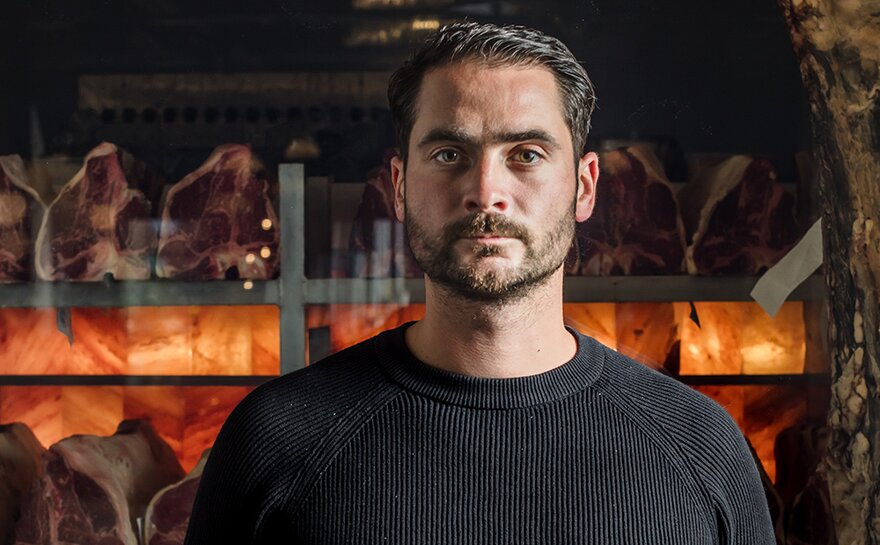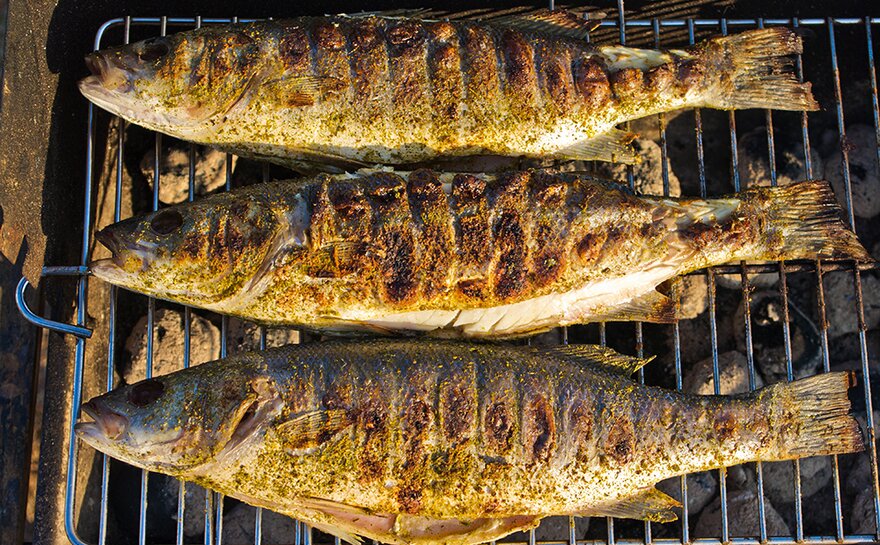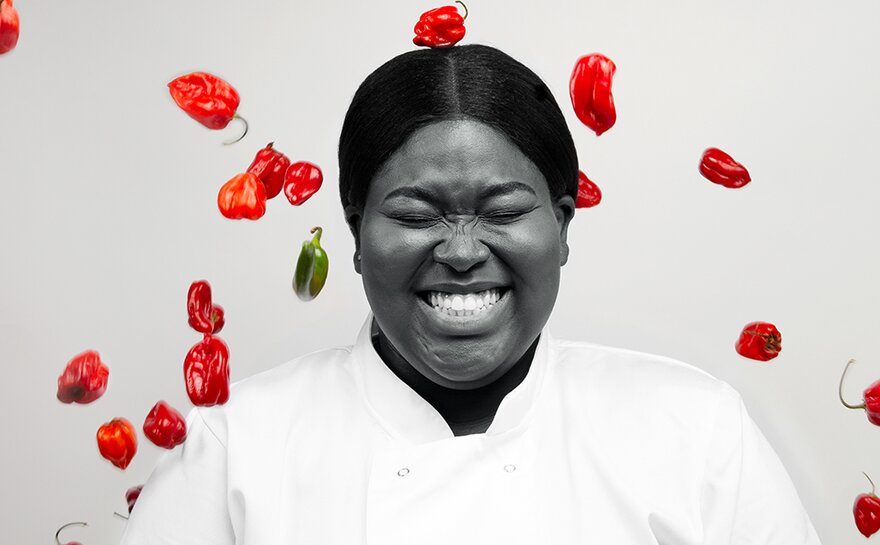Fire food is in fashion and with customers craving summer barbecues, now could be the perfect time to jump on the trend. We speak to six chefs experienced with smoke
Fire is the most primal cooking source available to chefs, but honing the flames to create the perfect char and smoke is no simple feat. From equipment to fuel and produce, there's a lot to consider.
Nathan Davies, chef patron of one-Michelin-starred SY23, Aberystwyth
The grills used in the kitchen of SY23 have been designed and built by chef-patron Nathan Davies, who makes adaptations through the year to tailer them to the produce he is cooking. He also makes his own shovels and rakes to tend the fire.
Fuel-wise Davies opts for birch logs, which he says "are really sweet and give off a really beautiful smokiness", but also burn consistently at an "incredibly" high temperature. He sources charcoal from a local company that produces an artisan lumpwood product.
Asked why he decided to place fire cooking at the heart of SY23 he says: "I decided that after 15 years of cooking in the more traditional sense that I enjoyed the challenge of cooking over something different. Having started cooking over fire I loved the way in which you have control over it. It varies every day with flavour, heat, burn time and just the way you can move the heat around to exactly what you need and then move on to the next course and adjust the fire to suit."
Davies' favourite things to cook over flame are fish and shellfish. He adds: "I feel you get the biggest difference when cooking fish and shellfish on the barbecue and I particularly enjoy cooking scallops on the fire."
Sam Elliott, founder of the Pasture and Parallel restaurants in Cardiff and Pasture and Radius restaurants in Bristol
Sam Elliott uses an Argentine grill for cooking meat and a charcoal oven. For fuel he favours wild cherry wood, which he says "gives a beautiful smoky flavour" as well as birch charcoal, produced from a byproduct of the furniture industry.
He explains: "Birch charcoal is very sustainable. We're taking the core of the birch tree, while the outside will be used in furniture. It's a waste material that's made into charcoal, so really, really sustainable. And wild cherry wood is native to the country and imparts an amazing flavour."
Elliott had always planned for Pasture, the first site of which opened in 2018, to centre around fire cooking. He says: "I've always had an interest in fire. It's a very primitive and natural way of cooking and imparting flavours that you can't really get with modern cooking methods. I've really got a passion for open flames, that smoke flavour and the char from cooking meat on direct heat.
"It takes a lot of time and a lot of skill to understand fire because every fire is different. Every fire will burn in a different way and every time you open the oven, you're injecting oxygen, which is then going to change the temperature, so it takes a real skill. It's all about controlling the oxygen flow and fuel essentially."
Elliott explains that putting together a menu has involved a lot of trial and error, seeing how produce cooks at different temperatures. He adds: "It's an amazing way of cooking and actually very delicate as well. A lot of people look at fire and think it's going to be quite fierce and intense, but actually, it's quite the opposite. We put sweet potatoes and cabbages directly into the coals and let them cook very gently and that's an amazing way of cooking. It imparts so much flavour because it's a lot slower and it reduces and concentrates flavour."
When it comes to meat Pasture's house cuts are porterhouse, tomahawk and chateaubriand. All beef is dry-aged in-house for a minimum of 45 days and Elliott uses a method of reverse searing, placing the beef into the charcoal oven to cook very gently before it is placed on a hot grill over wood to colour.
He says: "It's a much more delicate way of cooking and when you cut through the steak you get a really even colour, so if you want medium rare, you're going to get a beautiful medium rare all the way through. The smoke and flavour are imparted into it gently at the beginning and then the meat is allowed to relax before being seared right at the end. It's just a much better way of cooking."
Samantha Evans and Shauna Guinn, Hang Fire
When Evans and Guinn launched Hang Fire a decade ago, the American barbecues they wanted to cook on were difficult to source so they began making their own grills and smokers. Over the years they've also used Black Boc BBQ's parilla grills, Weber products, Napoleon Pro 22s and "fun grills", such as the portable ProQ Flatdog.
Explaining why they have made their careers around fire cooking they say: "On a primal level, fire has always been a source of warmth, food and gatherings. It's in our nature, our DNA, to want to be close to it. Our passion for cooking with wood and charcoal really ignited when we spent months in the southern states [of the US], with communities just doing this for fun, and sometimes in competition. We love the art, science and eventually, the instinct, this offers you as a cook.
"In general, our principles are that we love to cook any vegetables that are in season, and we buy less meat of a higher welfare. This is an expensive hobby, passion or living for many people, so everything from what fuel you choose to the choice of produce counts.
"We're not ones for standard barbecue fare, we're always pushing what we can cook outdoors as an extension of our kitchen. It's such an exciting way to cook."
Andrew Clarke, chef and co-founder of Acme Fire Cult, Dalston, London
When Andrew Clarke and Daniel Watkins opened Acme Fire Cult in east London they commissioned a custom-made grill, based on an Argentinian asador, from Tom Bray at Country Fire Kitchen, which is used alongside a variety of smokers. Recently the team have also had charcoal ovens custom made by the Cheeky Charlie Oven Company, expanding the range of cooking methods available to them. Clarke says: "We always write a menu around what we have and it's been very much a grill menu with a couple of things from the smoker for the low and slow stuff. Now we have the ovens, which are versatile in their own right. We can do cold smoking or really low temperature smoking, bake things and also leave things overnight."
The chef says he used to be obsessive about different types of wood, but now sticks to birch and oak. He explains: "We use kiln-dried oak from sustainable sources in Kent. Oak works with so many things and it's a dense wood so it burns long and hot, and birch is a smoky wood, so when we want to impart a bit more smoke we've got that."
Charcoal is sourced from Spain through the London Log Company. The Holmoak (Encina) charcoal is made from the branches of trees that yield the acorns for black Iberian pigs, which are coppiced as part of land management to give a higher acorn yield.
Clarke adds: "This stuff is incredible and that's why I justify using it [despite it needing to be imported]. It's really good and no British charcoal matches it, it's how hot it burns, how long it burns and how little ash comes off it."
The chef stresses that Acme Fire Cult is not about ‘low and slow', saying dishes cooked on the grill need to be ready to serve in a maximum of 20 minutes. He continues: "I love cooking fish that's been butterflied. We dry-age our fish for at least 36 hours in our Himalayan salt fridges – it dries the skin out perfectly, firms up the flesh and when you put it on the grill you don't have to worry about it sticking. I think fish is a real joy to cook, but also just a really beautiful piece of steak or pork chops are great too – it's so primal.
"When you cook amazing produce very simply in a method that's so archaic it brings us back to how we've evolved, the simplicity and those nuances of flavour. It brings out our ancestral selves." The restaurant's menu is between 50% and 70% vegetables and Clarke adds: "We use the best meat we can source in the UK and we want that to be the last thing people order after starting off with lots of small plates of delicious vegetables.
"Some of my favourite dishes are the vegetable dishes. It's not just grilling things – at the end of the night we fluff up the coals and put the leeks on for the next day, we do casseroles, braises and pot roasts in cast iron dishes."
Gareth Ward, chef-paton, Ynyshir, Eglwys Fach, Ceredigion
Gareth Ward uses Big Green Egg barbecues at two-Michelin-starred Ynyshir and fuels his grills with the company's charcoal, saying that, in his opinion, "it burns the best and tastes the nicest", as well as kiln-dried birch for finishing and adding flavour.
Most of the cooking at Ynyshir is done over fire and the chef says: "I love that it's quite a raw technique of cooking, all about instinct and knowledge. You've got to be able to cook to do it over fire, it's not just putting something in a water bath, it's about touch and feel and instinct and your skill of being of cook. You've got to learn and do your research by working in amazing restaurants and making mistakes. Making mistakes is very important – you only learn from making mistakes.
"You have to take everything into account, how much coal you put in, how much air is going in and also your kitchen environment, it's thinking on your feet constantly, you've got to be on your game all of the time, you have to think about where you rest things, how hot your kitchen is and constantly check – it's not easy."
One of Ward's favourite things to cook on the fire is an "outrageous" hamachi yellowtail tuna. He removes the belly, marinates it in teriyaki and then blackens it very quickly on the fire so it's still raw but has a crust on the outside.
Opeoluwa Odutayo, private chef
Opeoluwa Odutayo takes inspiration from her upbringing in Nigeria when cooking on charcoal and wood fires. She says: "My favourite things to cook on an open fire would have to be Nigerian beef suya, goat meat and jollof rice. I have been obsessed recently with cooking vegetables such as burnt aubergines and pumpkin."
She adds: "I have chosen open fire as my primary cooking method because that is what I have grown up seeing, it's a huge part of my food culture and heritage, the generations before me used it and I wish I could use it every day. Also, the flavours you achieve with open fire are so different to that in a pot. The wood, the smoke, everything just adds to the taste of whatever you are cooking."
Continue reading
You need to be a premium member to view this. Subscribe from just 99p per week.
Already subscribed? Log In







